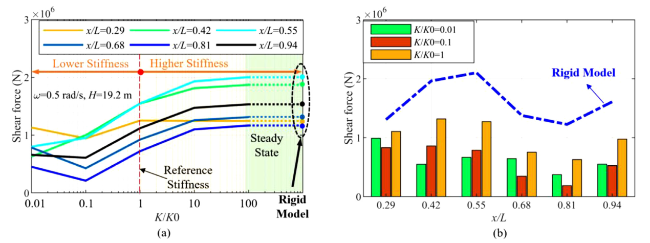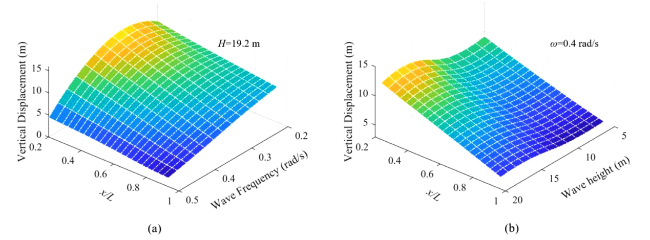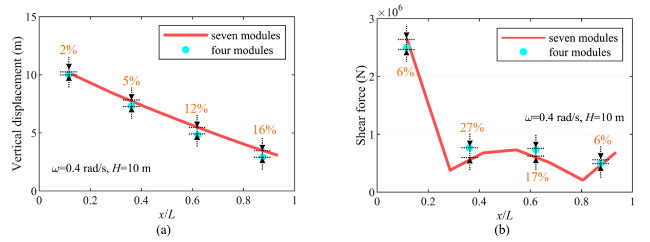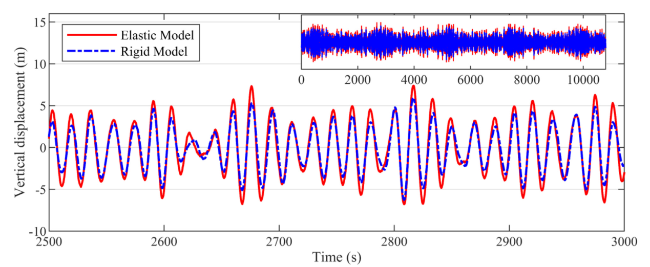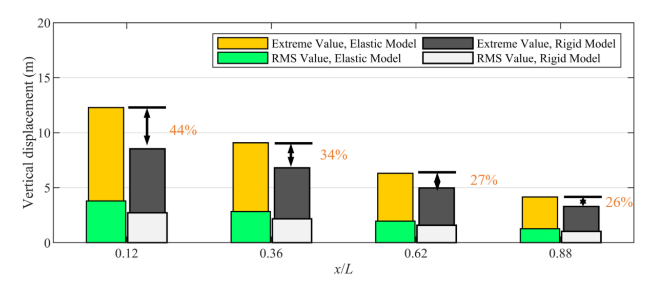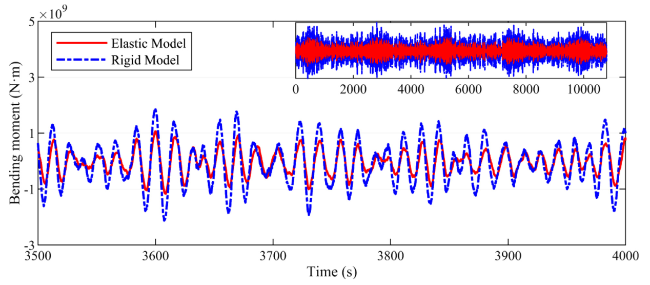1. Introduction
2. Numerical model of the vessel-shaped fish cage
Fig. 1. Model of the vessel-shaped fish cage. |
Table 1. Geometry and material parameters of the vessel-shaped fish cage. |
| Parameters | Unit | Value | |
|---|---|---|---|
| Floating-body length, LF | m | 385 | |
| Floating-body breadth, BF | m | 60 | |
| Floating-body height/draft, TF | m | 20 | |
| Size, D1 | m | 5 | |
| Size, D2 | m | 8 | |
| Size, D3 | m | 4 | |
| Main steel structure | Young's modulus, ES | GPa | 206 |
| Poisson's ratio, μ | - | 0.3 | |
| Density, ρS | kg/m3 | 7850 | |
| Diameter, B1 | m | 1 | |
| Diameter, B2 | m | 2 | |
| Section size, B3 | m | 2 × 1 | |
| Section size, B4 | m | 1.5 × 1.5 | |
| Net | Side length, BN | m | 45 |
| Net depth, HN | m | 40 | |
| Twine diameter, DN | mm | 5 | |
| Twine length, LN | mm | 50 | |
| Young's modulus, EN | GPa | 113 | |
| Solidity ratio | - | 0.19 | |
3. Theoretical background
3.1. Motion equation of the floating body
3.1.1. Motion equation of a multimodule system in the frequency domain
Fig. 2. Coordinate system of the multimodule system. |
3.1.2. Motion equation of the equivalent structural model in the time domain
Fig. 3. Equivalent elastic model. |
3.2. Loads on the nets and frames
3.2.1. Velocity field considering diffraction and radiation waves
3.2.2. Hydrodynamic loads on the net and frame
3.3. Hydroelasticity analysis method of the vessel-shaped fish cage
3.3.1. Motion equation of the coupled hydroelastic model
Fig. 4. Coupling model of the wetted part of the fish cage. |
3.3.2. Procedures of the hydroelasticity analysis
Fig. 5. Flowchart of the hydroelasticity response analysis of the vessel-shaped fish cage. |
4. Numerical results
4.1. Numerical validation
4.1.1. Validation of the equivalent structural model
Fig. 6. (a) Load condition and (b) deformation result of the original steel structure model and the equivalent elastic beam in the z direction. |
4.1.2. Validation of the motion response
Fig. 7. Time series of the vertical displacements in the wave period 15.8 s and wave height 4 m. |
4.2. Results under regular waves
4.2.1. Time series of the main structure response
Fig. 8. Time series of the vertical displacement at a wave height 19.2 m and wave period 15.8 s. |
Fig. 9. Time series of the cross-sectional shear force at a wave height 19.2 m and wave period 15.8 s. |
Fig. 10. Time series of the cross-sectional vertical bending moment at a wave height 19.2 m and wave period 15.8 s. |
4.2.2. Effects of elasticity of the main structure on the net twine tension
Fig. 11. Time series of the twine tension for a wave height of 19.2 m. (a) Twine tension at the cage bow. (b) Twine tension at the cage midship. (c) Twine tension at the cage stern. |
4.2.3. Effects of the elasticity of the main structure
Fig. 12. (a) Vertical displacement amplitude at different cross-sections and (b) vertical elastic deformation under smaller cross-sectional stiffness. |
Fig. 13. (a) Shear force amplitude at different cross-sections and (b) shear force amplitude under smaller cross-sectional stiffness. |
Fig. 14. (a) Vertical bending moment amplitude at different cross-sections and (b) vertical bending moment amplitude under smaller cross-sectional stiffnesses. |
4.2.4. Results under different wave frequencies and wave heights
Fig. 15. Vertical displacement amplitude in different wave cases. (a) Results for different frequencies. (b) Results for different wave heights. |
Fig. 16. Cross-sectional force amplitude for different wave frequencies and a wave height of 19.2 m. (a) Shear force. (b) Vertical bending moment. |
Fig. 17. Cross-sectional force amplitude at different wave heights at a wave frequency of 0.4 rad/s: (a) shear force and (b) vertical bending moment. |
4.3. Results of different modules for the regular waves
Fig. 18. Results under different number of modules. (a) Vertical displacement. (b) Cross-sectional shear force (default global stiffness K0). |
4.4. Results under irregular waves
4.4.1. Motion response
Fig. 19. Time series of the vertical displacement at x/L = 0.5 under irregular waves (default global stiffness K0). |
Fig. 20. Vertical displacement statistical results of different cross-sections under irregular waves (default global stiffness K0). |
4.4.2. Cross-sectional load effect
Fig. 21. Time series of the cross-sectional shear force at x/L = 0.5 under irregular waves (default global stiffness K0). |
Fig. 22. Time series of the cross-sectional vertical bending moment at x/L = 0.5 under irregular waves (default global stiffness K0). |
Fig. 23. The statistical results of cross-sectional load effects under irregular waves (default global stiffness K0). (a) Shear force. (b) Vertical bending moment. |














